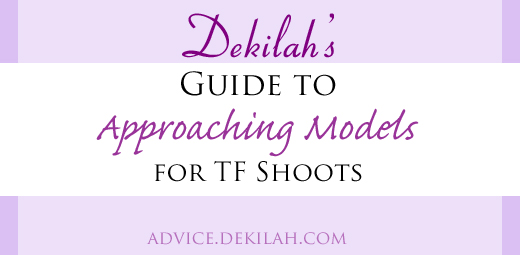Avoiding model flakes is something I think all photographers would like to do and I hope this article will help you identify some of the red flags you may encounter.
First, I want to define what I, and most people, consider flaking: model flakes are models who do not show up to the shoot or who cancel at the last possible second (as in day of the shoot) without a legitimate excuse. Models who cancel with a legitimate excuse are generally not considered flakes.
I think in order to cut down on your flake rate, you need to examine your situation. Sometimes there were no warning signs before a model flaked. But often if you check references or at least ask around, look at how they communicate, and read their profile, then you can catch some red flags common to many model flakes. Again, sometimes there is nothing you could have done. And it is not your fault. Models should not flake, but it does happen and if you can do things to avoid it, you should. These tips are from my own experiences working with other models, from forums, and from photographers I’ve talked to over the years.
Some Guidelines to Avoid Model Flakes
Keep in mind that these are guidelines, not hard and fast rules, a model who doesn’t fit one or even two of these guidelines may still be okay, but the more warning flags you see, the higher the chance of a model flake in most cases.
1. If you are booking via a modeling site, look for a well-written profile that shows some degree of dedication to modeling.
2. Look at messages you receive from the model. Is the model asking for any missing info? Does she seem into the concept by offering some insight, suggestions, or at least mentioning something specific pertaining to the idea versus just saying “I love that idea!”? Does she confirm the location and date or just say “That sounds good”? Not saying that some of us do not respond with short replies some times, but there should be some degree of real interest at some point.
Note: this one may vary from model to model and situation to situation. Many traveling models or very busy models may not have as much time to communicate.
3. Ask her for ideas she wants to shoot or input on the concept if the shoot is TF. Maybe she likes the one concept so much she wants to just focus on that, or maybe she does have ideas she might like to try as well. The key is that she seems to feel she is getting something she wants out of it. Don’t forget that the whole point of TF is to trade.
4. Make sure you send the time, date, location (address) and your number in one message once all is confirmed. Include anything she is expected to bring or do (such as hair or make-up) and a quick note of the concept. This is really helpful for referring back to and some models even do this confirmation themselves to avoid any confusion.
5. Ask around about the model. Get references if you can, but also ask around in your circles. I do this a lot with photographers I am working with for the first time. Keep in mind that you may now be getting second or third hand info, but a lot of good responses is usually pretty promising. One or two negative responses from a large pool can mean personal issues or lack of a creative click, but not necessarily an issue for you. I would not consider this a way to decide whether to cancel or book a shoot myself. I only use it to get an idea, unless something is pretty serious or I keep hearing the same bad thing happened over and over (as in multiple shoots, not just the same story retold).
6. Consider a back up model. Have someone on call who you have shot with before, that way if the planned model cancels, you might still be able to shoot anyway. I think this is especially good if you are booking a location/studio or have hair/MU coming (just let them know).
7. Be cautious when booking a model you have not worked with before for a shoot that you are pouring a lot of resources into. For example, booking a new-to-you model for a shoot that you are investing a lot of money into or scheduling hair, wardrobe, etc, for may be risky unless they have glowing references. If you do this, I recommend definitely considering #6.
Potential Reasons for Model Flakes
The second thing you really need to consider is who models are. A lot of models are young women. Women between the ages of 18 and 25 can be going through a lot of life changes and some of them are not used to being held responsible and accountable. Some of them party, some are not good at keeping schedules, some have demanding boyfriends who they are very attached to and trying to keep happy (whether you think they should or not), etc. This is pretty normal for this age, the ones who are super responsible are the exceptions. They also may be in college and trying to study and cram for classes. They also may not have reliable transportation. Most models who are serious about modeling will be responsible and will find ways to cut down on the chances that they will not be able to show up, but there are a lot of girls who are new to modeling or not quite as serious.
What NOT to Do
So many times I see discussions about model flakes and I see generally poor advice being thrown around.
A common “solution” that always seems to come up is charging models some sort of booking fee. This is quite ineffective if you’re looking for quality, somewhat experienced models. It makes us feel un-trusted, it makes you seem pushy, and most of us simply don’t have the extra cash to give you. On top of that, we feel like we’re being punished for the few bad eggs.
Don’t take to social media or your profile with rants about it or shove it in the face of your potential models that you won’t tolerate flakes. Any model with any sort of real interest knows that flaking is horrible and a lot of us are even scared to call if we get sick or injured for fear we’ll be labeled a flake.
How To Handle a Pattern of Model Flakes
I covered this a bit in my first paragraph, but try not to get discouraged. If you have a lot of flakes, it might be time to examine what the cause of that might be. It might just be a string of “bad luck” and may have nothing to do with you. It might just be that you are choosing the wrong models. Try looking outside of your usual range (age, look, area, etc) and see if that helps. It might help to ask good models you have worked with if they have suggestions of reliable models for you to work with as well. Similarly, try finding local groups on FB and MM and see what models people seem to work with regularly. That would be a good place to start to find reliable models.
If you found this article helpful, please share it and consider supporting this blog via PayPal (you can choose any amount).




